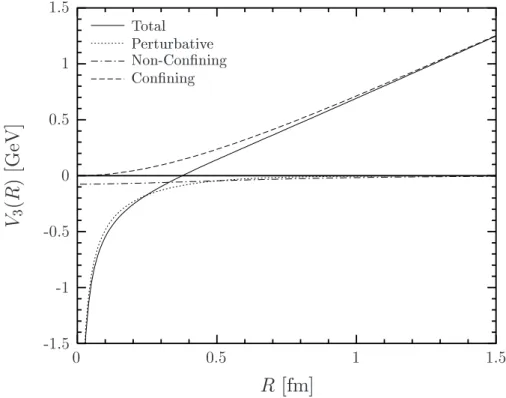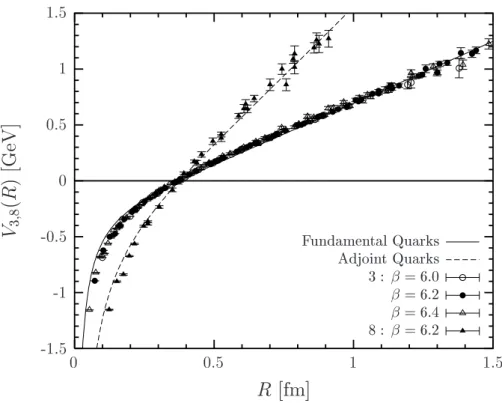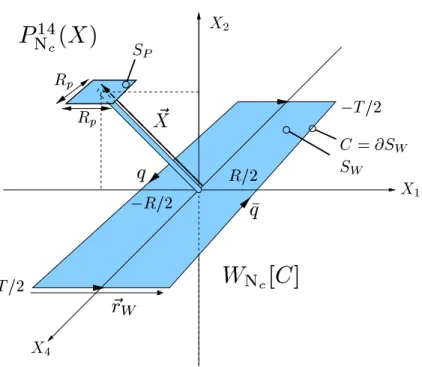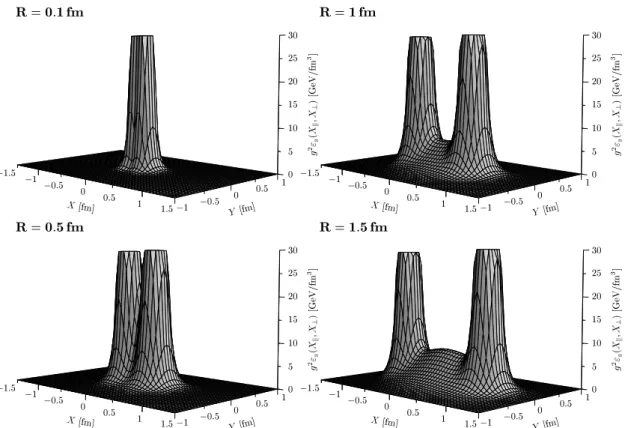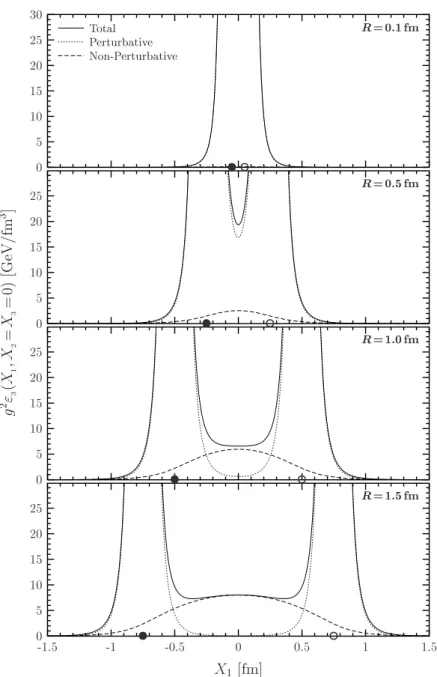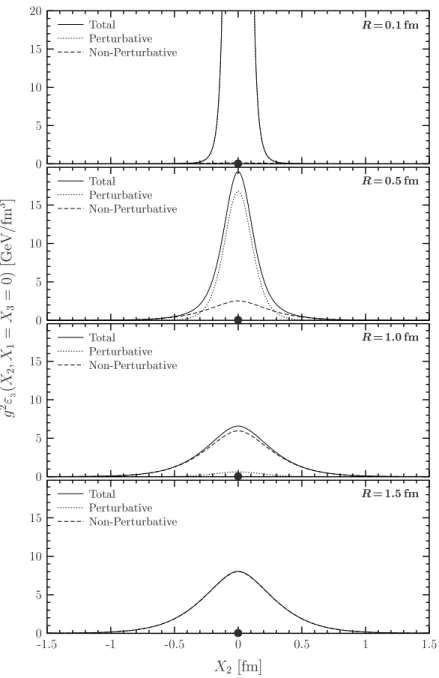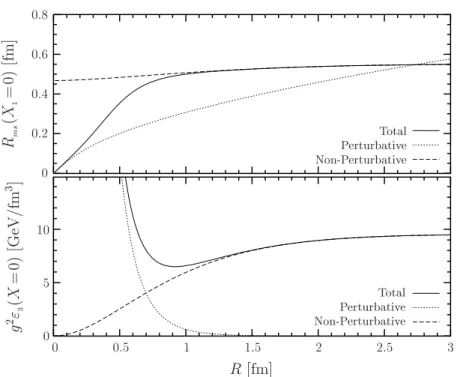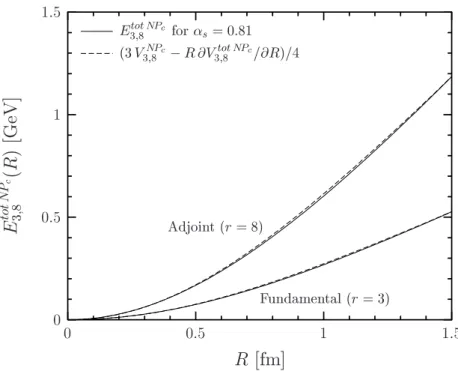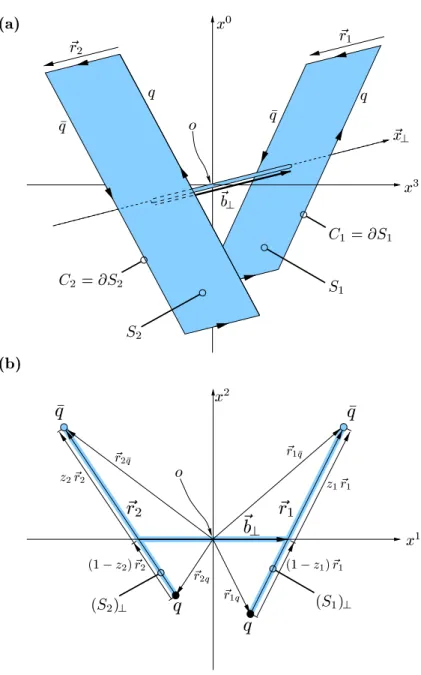Dissertation
submitted to the
Combined Faculties for the Natural Sciences and for Mathematics of the Ruperto–Carola University of Heidelberg, Germany
for the degree of Doctor of Natural Sciences
presented by
Diplom–Physiker Frank Daniel Steffen
born in Wattenscheid
Oral examination: February 14, 2003
From Static Potentials to
High-Energy Scattering
Referees: Prof. Dr. Hans G¨unter Dosch Prof. Dr. Bogdan Povh
Von Statischen Potenzialen zur Hochenergiestreuung Zusammenfassung
Wir entwickeln ein Loop-Loop Korrelations Modell zur einheitlichen Beschreibung von statischen Farbdipol Potenzialen, einschliessenden QCD Strings, und hadronischen Hochenergiereaktio- nen mit besonderer Ber¨ucksichtigung von S¨attigungseffekten, die die S-Matrix Unitarit¨at bei extrem hohen Energien manifestieren. Das Modell verbindet st¨orungstheoretischen Gluonaus- tausch mit dem nicht-st¨orungstheoretischen Modell des Stochastischen Vakuums, das den Ein- schluss von Farbladungen durch Flussschlauchbildung der Farbfelder beschreibt. Wir berech- nen Farbfeldverteilungen statischer Farbdipole in verschiedenen SU(Nc) Darstellungen und finden Casimir Skalierungsverhalten in ¨Ubereinstimmung mit aktuellen Gitter-QCD Ergeb- nissen. Wir untersuchen die im einschliessenden String gespeicherte Energie und zeigen mit Niederenergietheoremen die Konsistenz mit dem statischen Quark-Antiquark Potenzial. Wir verallgemeinern Meggiolaros Analytische Fortsetzung von Parton-Parton auf Dipol-Dipol Streu- ung und erhalten einen Euklidischen Zugang zur Hochenergiestreuung, der prinzipiell erlaubt, Streumatrixelemente in Gitter-QCD zu berechnen. Mit dem Euklidischen Loop-Loop Korrela- tions Modell berechnen wir in diesen Zugang Dipol-Dipol Streuung bei hohen Energien. Das Ergebnis bildet zusammen mit einer universellen Energieabh¨angigkeit und reaktionsspezifischen Wellenfunktionen die Grundlage f¨ur eine einheitliche Beschreibung von pp,πp, Kp,γ∗p undγγ Reaktionen in guter ¨Ubereinstimmung mit experimentellen Daten f¨ur Wirkungsquerschnitte, Steigungsparameter und Strukturfunktionen. Die erhaltenen Stossparameterprofile f¨ur pp und γ∗Lp Reaktionen und die stossparameterabh¨angige Gluonverteilung des ProtonsxG(x, Q2,|~b⊥|) zeigen S¨attigung bei extrem hohen Energien in ¨Ubereinstimmung mit Unitarit¨atsgrenzen.
From Static Potentials to High-Energy Scattering Abstract
We develop a loop-loop correlation model for a unified description of static color dipole po- tentials, confining QCD strings, and hadronic high-energy reactions with special emphasis on saturation effects manifesting S-matrix unitarity at ultra-high energies. The model combines perturbative gluon exchange with the non-perturbative stochastic vacuum model which describes color confinement via flux-tube formation of color fields. We compute the chromo-field distri- butions of static color dipoles in various SU(Nc) representations and find Casimir scaling in agreement with recent lattice QCD results. We investigate the energy stored in the confining string and use low-energy theorems to show consistency with the static quark-antiquark po- tential. We generalize Meggiolaro’s analytic continuation from parton-parton to dipole-dipole scattering and obtain a Euclidean approach to high-energy scattering that allows us in principle to calculateS-matrix elements in lattice QCD. In this approach we compute high-energy dipole- dipole scattering with the Euclidean loop-loop correlation model. Together with a universal energy dependence and reaction-specific wave functions, the result forms the basis for a unified description of pp, πp, Kp, γ∗p, and γγ reactions in good agreement with experimental data for cross sections, slope parameters, and structure functions. The obtained impact parameter profiles for pp and γL∗p reactions and the impact parameter dependent gluon distribution of the protonxG(x, Q2,|~b⊥|) show saturation at ultra-high energies in accordance with unitarity constraints.
Contents
1 Introduction 1
2 The Loop-Loop Correlation Model 7
2.1 Vacuum Expectation Value of a Wegner-Wilson Loop . . . 7
2.2 The Loop-Loop Correlation Function . . . 10
2.3 Perturbative and Non-Perturbative QCD Components . . . 15
3 Static Color Dipoles and Confining QCD Strings 19 3.1 The Static Color Dipole Potential . . . 19
3.2 Chromo-Field Distributions of Color Dipoles . . . 24
3.3 Low-Energy Theorems . . . 33
4 Euclidean Approach to High-Energy Scattering 37 4.1 Functional Integral Approach to High-Energy Scattering . . . 37
4.2 Analytic Continuation of Dipole-Dipole Scattering . . . 40
4.3 Dipole-Dipole Scattering in the Loop-Loop Correlation Model . . . 42
4.4 Comments on the QCD van der Waals Potential . . . 46
5 Hadronic Wave Functions and Universal Energy Dependence 49 5.1 Hadron and Photon Wave Functions . . . 49
5.2 Universal Energy Dependence . . . 51
5.3 Model Parameters for High-Energy Scattering . . . 54
6 Impact Parameter Profiles and Gluon Saturation 55 6.1 S-Matrix Unitarity Constraints . . . 55
6.2 The Profile Function for Proton-Proton Scattering . . . 56
6.3 The Profile Function for Photon-Proton Scattering . . . 58
6.4 A Scenario for Gluon Saturation . . . 61
7 Comparison with Experimental Data 65 7.1 Total Cross Sections . . . 66
7.2 The Proton Structure Function . . . 69
7.3 The Slope B of Elastic Forward Scattering . . . 72
7.4 The Differential Elastic Cross Section . . . 74
7.5 The Elastic Cross Section σel,σel/σtot and σtot/B . . . 77
8 Conclusion 81
A Loop and Minimal Surface Parametrizations 87
B χ-Computations with Minimal Surfaces 89
Chapter 1
Introduction
According to our present understanding,quantum chromodynamics(QCD) is the theory of strong interactions and thus describes the diversity of strong interaction phenom- ena [1]. QCD is the gauge field theory defined by the non-Abelian color gauge group SU(Nc) withNc = 3 colors [2] and the presence of a certain number of quark fieldsψq
(q =u, d, s, ...) in the fundamental representation. The Lagrange density of QCD has an extremely simple form
LQCD(x) =−1
4Gµνa (x)Ga µν(x) +X
q
ψ¯q(x)
iγµ(∂µ+igGµataNc)−mq ψq(x) (1.1) and involves only very few parameters, i.e. the gauge couplingg and the current quark massesmq. The first term describes pure gauge theory of the massless gluon potentials Gaµ(x) (a= 1, ..., Nc2−1) in terms of the gluon field strengths
Gµνa (x) =∂µGνa(x)−∂νGµa(x)−gfabcGµb(x)Gνc(x), (1.2) wherefabcare the structure constants of the gauge group SU(Nc). The second term is a sum over the contributions of the quarks with flavor q =u, d, s, ... and involves the SU(Nc) generators tar in the fundamental representationr = Nc.
The simple Lagrangian (1.1) brings along a very rich structure. Due to vacuum polarization, the effective coupling depends on the distance scale, or equivalently the (inverse) energy scale, at which it is measured: As long as there are no more than Nf = 16 quark flavors, the renormalization group tells us that the effective coupling becomes small at short distances and thus that QCD is an asymptotically free theory [3].
Indeed, high-energy deep inelastic scattering experiments reveal that quarks behave as free particles at short distances. Accordingly, perturbation theory is applicable in this regime and allows reliable analytic calculations, for example, of the total cross section for electron-positron annihilation into hadrons [4, 5]. At distance scales of order of the proton size (≈ 1 fm), the effective coupling becomes large so that perturbation theory breaks down.
Genuinely non-perturbative methods are needed to describe the physics of hadrons and low-energy interactions [6]. Indeed, an analytic derivation of color confinement – the phenomenon that quarks and gluons cannot be observed as isolated particles – from the QCD Lagrangian is still missing and among the ultimate goals in theoretical physics.
Further fundamental strong interaction phenomena at low energy are spontaneous chiral symmetry breaking and dynamical mass generation, i.e. the hadron spectrum and the origin of the hadron mass, which are inherently non-perturbative phenomena as well not yet proven analytically from the QCD Lagrangian.
A challenge at high energy is the description and understanding of hadronic high- energy scattering [7]. For small momentum transfers, the effective QCD coupling is again too large for a reliable perturbative treatment and non-perturbative methods are needed.
In particular, it is a key issue to unravel the effects of confinement and topologically non-trivial gauge field configurations (such as instantons) on such reactions [8, 9].
The most interesting phenomenon in hadronic high-energy scattering is the rise of the total cross sections with increasing c.m. energy √
s: While the rise is slow in hadronic reactions oflarge particles such as protons, pions, kaons, or real photons [10], it is steep if only onesmall particle is involved such as an incoming virtual photon [11–
15] or an outgoing charmonium [16, 17]. This energy behavior is best displayed in the proton structure function F2(x, Q2) that is equivalent to the total γ∗p cross section σtotγ∗p(s, Q2). With increasing photon virtuality Q2, the increase of F2(x, Q2) towards small Bjorken x = Q2/s becomes significantly stronger. Together with the steep rise of the gluon distribution in the proton xG(x, Q2) with decreasing x, the rise of the structure functionF2(x, Q2) towards smallx [11–15] is one of the most exciting results of the HERA experiments.
In high-energy collisions of stable hadrons, the rise of the total cross sections is limited: The Froissart bound, derived from very general principles such as unitarity and analyticity of the S-matrix, allows at most a logarithmic energy dependence of the cross sections at asymptotic energies [18]. Analogously, the rise of σtotγ∗p(s, Q2) is expected to slow down. The microscopic picture behind this slow-down is the concept of gluon saturation: Since the gluon density in the proton becomes large at high energies
√s(smallx), gluon fusion processes are expected to tame the growth ofσγtot∗p(s, Q2). It is a key issue to determine the energy at which these processes become significant.
Lattice QCD is the principal theoretical tool to study non-perturbative aspects of the QCD Lagrangian from first principles. Numerical simulations of QCD on Euclidean lattices give strong evidence for color confinement and spontaneous chiral symmetry breaking and describe dynamical mass generation from the QCD Lagrangian [19–21].
However, since lattice QCD is limited to the Euclidean formulation of QCD, it cannot be applied in Minkowski space-time to simulate high-energy reactions in which particles are inherently moving near the light-cone. Furthermore, it is hard to understand from sim- ulations the important QCD mechanisms that lead, for example, to color confinement.
Here (phenomenological) models that allow analytic calculations are important.
In this thesis we develop a loop-loop correlation model (LLCM) for a unified de- scription of static quark-antiquark potentials and confining QCD strings in Euclidean space-time [22] and hadronic high-energy reactions in Minkowski space-time [23, 24] with special emphasis on saturation effects manifestingS-matrix unitarity at ultra-high ener- gies [25, 26]. The model is constructed in Euclidean space-time. It combines perturba- tive gluon exchange with thestochastic vacuum model(SVM) of Dosch and Simonov [27]
which leads to confinement via a string of color fields [22, 28, 29]. For applications to high-energy scattering, the LLCM can be analytically continued to Minkowski space- time [23] following the procedure introduced for applications of the SVM to high-energy reactions [30–32]. In this way the LLCM allows us to investigate manifestations of the confining QCD string in unintegrated gluon distributions of hadrons and photons [24].
We present an alternative Euclidean approach to high-energy scattering that shows how one can access high-energy scattering in lattice simulations of QCD. Indeed, this approach allows us to compute S-matrix elements for dipole-dipole scattering in the Euclidean LLCM and confirms the analytic continuation of the model to Minkowski space-time [22]. The applications of the LLCM to high-energy scattering are based on the functional integral approach developed for parton-parton scattering [33, 34] and extended to gauge-invariant dipole-dipole scattering [30–32]; see also Chap. 8 of [35].
Together with a universal energy dependence introduced phenomenologically, the func- tional integral approach to dipole-dipole scattering is the key to the presented unified description of hadron-hadron, photon-hadron, and photon-photon reactions.
The central element in our approach is the gauge-invariant Wegner-Wilson loop [36, 37]: The considered physical quantities are obtained from the vacuum expectation value (VEV) of one Wegner-Wilson loop,hWr[C]i, and the correlation of two Wegner-Wilson loops, hWr1[C1]Wr2[C2]i. Herer(i) indicates theSU(Nc) representation of the Wegner- Wilson loops which we keep as general as possible. In phenomenological applications, the propagation of (anti-)quarks requires the fundamental representation, r = Nc, and the propagation of gluons the adjoint representation, r = N2c−1. We express hWr[C]i andhWr1[C1]Wr2[C2]iin terms of the gauge-invariant bilocal gluon field strength corre- lator integrated over minimal surfaces by using the non-Abelian Stokes theorem and a matrix cumulant expansion in the Gaussian approximation. We decompose the gluon field strength correlator into a perturbative and a non-perturbative component. Here the SVM is used for the non-perturbative low-frequency background field [27] and per- turbative gluon exchange for the additional high-frequency contributions. This com- bination allows us to describe long and short distance correlations in agreement with lattice calculations of the gluon field strength correlator [38, 39]. Moreover, it leads to a static quark-antiquark potential with color Coulomb behavior for small source sep- arations and confining linear rise for large source separations. We calculate the static quark-antiquark potential with the LLCM parameters adjusted in fits to high-energy scattering data [23] and find good agreement with lattice data. We thus have one model that describes both static hadronic properties and high-energy reactions of hadrons and photons in good agreement with experimental and lattice QCD data.
We apply the LLCM to compute thechromo-electric fieldsgenerated by a static color dipole in the fundamental and adjoint representation of SU(Nc). The non-perturbative SVM component describes the formation of a color flux tube that confines the two color sources in the dipole [22, 28, 29] while the perturbative component leads to color Coulomb fields. We findCasimir scalingfor both the perturbative and non-perturbative contributions to the chromo-electric fields in agreement with lattice data and our results for the static dipole potential, which is the potential of a static quark-antiquark pair in case of the fundamental representation and the potential of a gluino pair in case of the adjoint representation. The mean squared radius of the confining QCD string is calculated as a function of the dipole size. Transverse and longitudinal energy density profiles are provided to study the interplay between perturbative and non-perturbative physics for different dipole sizes. The transition from perturbative to string behavior is found at source separations of about 0.5 fm in agreement with the recent results of L¨uscher and Weisz [40].
Thelow-energy theorems, known in lattice QCD as Michael sum rules [41], relate the energy and action stored in the chromo-fields of a static color dipole to the corresponding ground state energy. The Michael sum rules, however, are incomplete in their original form [41]. We present the complete energy and action sum rules [42–44] in continuum theory taking into account the contributions to the action sum rule found in [29] and the trace anomaly contribution to the energy sum rule found in [42]. Using these corrected low-energy theorems, we compare the energy and action stored in the confining string with the confining part of the static quark-antiquark potential. This allows us to confirm consistency of the model results and to determine the values of the β- function and the strong coupling αs at the renormalization scale at which the non-perturbative SVM component is working. Earlier investigations along these lines have been incomplete since only the contribution from the traceless part of the energy-momentum tensor has been considered in the energy sum rule.
To study the effect of the confining QCD string examined in Euclidean space-time on high-energy reactions in Minkowski space-time, an analytic continuation from Eu- clidean to Minkowski space-time is needed. For investigations of high-energy reactions in our model constructed in Euclidean space-time, the gauge-invariant bilocal gluon field strength correlator can be analytically continued from Euclidean to Minkowski space- time. As mentioned above, this analytic continuation has been introduced by Dosch and collaborators for applications of the SVM to high-energy reactions [30–32] and is used also in our Minkowskian applications of the LLCM [23–26]. Recently, an alternative an- alytic continuation for parton-parton scattering has been established in the perturbative context by Meggiolaro [45]. This analytic continuation has already been used to access high-energy scattering from the supergravity side of the AdS/CFT correspondence [46], which requires a positive definite metric in the definition of the minimal surface [47], and to examine the effect of instantons in high-energy scattering [48].
In this thesis we generalize Meggiolaro’s analytic continuation [45] from parton- parton to gauge-invariantdipole-dipole scatteringsuch that S-matrix elements for high-
energy reactions can be computed from configurations of Wegner-Wilson loops in Eu- clidean space-time and with Euclidean functional integrals. This evidently shows how one can access high-energy reactions directly in lattice QCD. First attempts in this direction have already been carried out but only very few signals could be extracted, while most of the data was dominated by noise [49]. We apply this approach to compute the scattering of dipoles at high-energy in the Euclidean LLCM: We recover exactly the result derived with the analytic continuation of the gluon field strength correlator [23].
This confirms the analytic continuation used in all earlier applications of the SVM to high-energy scattering [30–32, 50–61] including the Minkowskian applications of the LLCM [23–26]. Here we use the obtainedS-matrix elementSDD as the basis for our uni- fied description of hadronic high-energy reactions with special emphasis on saturation effects in hadronic cross sections and gluon saturation [23, 25, 26]. Moreover, we have used the obtainedS-matrix element to investigate manifestations of the confining string in high-energy reactions of hadrons and photons [24]. In particular, we have found that the string can be represented as an integral over stringless dipoles with a given dipole number density. This decomposition of the confining string into dipoles gives insights into the microscopic structure of the model. It allows us to calculate unintegrated gluon distributions of hadrons and photons from dipole-hadron and dipole-photon cross sec- tions via |~k⊥| factorization. Our result shows explicitly that non-perturbative physics dominates the unintegrated gluon distributions at small transverse momenta|~k⊥|[24].
Aiming at a unified description of hadron-hadron, photon-hadron, and photon- photon reactions, we follow the functional integral approach to high-energy scattering in the eikonal approximation [30, 31, 33, 34] (cf. also Chap. 8 of [35]) in whichS-matrix elements factorize into the universal S-matrix element for elastic high-energy dipole- dipole scatteringSDDand reaction-specific light-cone wave functions. The color dipoles – described by light-like Wegner-Wilson loops – are given by the quark and antiquark in the meson or photon and in a simplified picture by a quark and diquark in the baryon. Consequently, hadrons and photons are described as color dipoles with size and orientation determined by appropriate light-cone wave functions [31, 34].
We introduce a phenomenological energy dependence into the univeral S-matrix el- ement for dipole-dipole scattering SDD in order to describe simultaneously the energy behavior in hadron-hadron, photon-hadron, and photon-photon reactions involving real and virtual photons as well. Motivated by the two-pomeron picture of Donnachie and Landshoff [62], we ascribe to our non-perturbative (soft) and perturbative (hard) com- ponent a weak and strong energy dependence, respectively. Including multiple gluonic interactions, we obtain S-matrix elements with a universal energy dependence that respects unitarity constraints in impact parameter space.
To study saturation effects that manifest S-matrix unitarity, we consider the scat- tering amplitudes in impact parameter space, where S-matrix unitarity imposes rigid limits on the impact parameter profiles such as theblack disc limit. We confirm explic- itly that our model respects this unitarity constraint for dipole-dipole scattering, which is the underlying process of each considered reaction in our approach. We calculate the
impact parameter profiles for proton-proton and longitudinal photon-proton scattering.
The profile functions describe the blackness or opacity of the interacting particles and give an intuitive geometrical picture for the energy dependence of the cross sections. At ultra-high energies, the hadron opacity saturates at the black disc limit which tames the growth of the hadronic cross sections in agreement with the Froissart bound [18]. We es- timate the impact parameter dependent gluon distributionof the protonxG(x, Q2,|~b⊥|) from the profile function for longitudinal photon-proton scattering and find gluon satu- ration at small Bjorken xthat tames the steep rise of the integrated gluon distribution xG(x, Q2) towards small x. These saturation effects manifest S-matrix unitarity in hadronic collisions and should be observable in future cosmic ray and accelerator ex- periments at ultra-high energies. The c.m. energies and Bjorken x at which saturation sets in are determined and LHC and THERA predictions are given.
With the intuitive geometrical picture gained in impact parameter space, we turn to experimental observables to analyse the energy dependence of the cross sections and to localize saturation effects. We compare the LLCM results with experimental data and provide predictions for future cosmic ray and accelerator experiments. Total cross sections σtot, the structure function of the proton F2, slope parameters B, differential elastic cross sections dσel/dt, elastic cross sections σel, and the ratios σel/σtot and σtot/B are considered for proton-proton, pion-proton, kaon-proton, photon-proton, and photon-photon reactions involving real and virtual photons as well.
The outline of this thesis is as follows: In Chap. 2 the loop-loop correlation model is developed in its Euclidean version and the general computations of hWr[C]i and hWr1[C1]Wr2[C2]i are presented. Based on these evaluations, we compute in Chap. 3 potentials and chromo-field distributions of static color dipoles with emphasis on Casimir scaling and the interplay between perturbative color Coulomb behavior and non-per- turbative formation of the confining QCD string. Moreover, low-energy theorems are discussed and used to show consistency of the model results and to determine the values ofβandαsat the renormalization scale at which the non-perturbative SVM component is working. In Chap. 4 the Euclidean approach to high-energy scattering is presented and applied to compute high-energy dipole-dipole scattering in our Euclidean model.
The additional ingredients for the unified description of hadronic high-energy scatter- ing, i.e. hadron and photon wave functions and the phenomenological universal energy dependence, are introduced in Chap. 5. Going to impact parameter space in Chap. 6, we confirm the unitarity condition in our model, study the impact parameter profiles for proton-proton and photon-proton scattering, and discuss the impact parameter de- pendent gluon distribution of the proton xG(x, Q2,|~b⊥|) and gluon saturation. Finally, in Chap. 7 we present the phenomenological performance of the LLCM and provide predictions for saturation effects in experimental observables. In the Appendices we give explicit parametrizations of the loops and the minimal surfaces and provide the detailed computations for the results in the main text.
Chapter 2
The Loop-Loop Correlation Model
In this chapter the vacuum expectation value (VEV) of one Wegner-Wilson loop and the correlation of two Wegner-Wilson loops are computed for arbitrary loop geome- tries within a Gaussian approximation in the gluon field strengths. The results are applied in the following chapters. We describe our model for the QCD vacuum in which the stochastic vacuum model (SVM) of Dosch and Simonov [27] is used for the non-perturbative low-frequency background field (long-distance correlations) and per- turbative gluon exchange for the additional high-frequency contributions (short-distance correlations). In this and the next chapter we work in Euclidean space-time as indicated by exclusively subscript Dirac indices and space-time variables written in capital letters.
2.1 Vacuum Expectation Value of a Wegner-Wilson Loop
A crucial quantity in gauge theories is the Wegner-Wilson loop operator [36, 37]
Wr[C] = ˜TrrPexp
−ig I
C
dZµGµa(Z)tar
. (2.1)
Concentrating on SU(Nc) Wegner-Wilson loops, where Nc is the number of colors, the subscript r indicates a representation of SU(Nc), ˜Trr(...) = Trr(...)/Trr1lr is the normalized trace in the corresponding color space with unit element 1lr,g is the strong coupling, andGµ(Z) =Gµa(Z)taris the gluon potential with theSU(Nc) group generators in the corresponding representation, tar, that demand the path ordering indicated by P on the closed path C in space-time. A distinguishing theoretical feature of the Wegner-Wilson loop is its invariance under local gauge transformations in color space.
Therefore, it is the basic object in lattice gauge theories [19, 20, 36, 37, 63] and has been considered as the fundamental building block for a gauge theory in terms of gauge
invariant variables [64]. Phenomenologically, the Wegner-Wilson loop represents the phase factor associated to the propagation of a very massive or very fast color source in the representation r of the gauge groupSU(Nc).
To compute the expectation value of a Wegner-Wilson loop (2.1) in the QCD vacuum D
Wr[C]
E
G=
DTr˜rPexp
−i g I
C
dZµGµa(Z)tar E
G , (2.2)
we transform the line integral over the loop C into an integral over the surface S with
∂S=C by applying the non-Abelian Stokes’ theorem [65]
D Wr[C]
E
G =
DTr˜rPSexp
−ig 2
Z
S
dσµν(Z)Gµνa (O, Z;CZO)tar E
G , (2.3) where PS indicates surface ordering and O is an arbitrary reference point on the sur- face S. In Eq. (2.3) the gluon field strength tensor, Gµν(Z) = Gµνa (Z)ta, is parallel transported to the reference point O along the path CZO
Gµν(O, Z;CZO) = Φ(O, Z;CZO)−1Gµν(Z)Φ(O, Z;CZO) (2.4) with the QCD Schwinger string
Φ(O, Z;CZO) =Pexp
−i g Z
CZO
dZµGµa(Z)tar
. (2.5)
The QCD vacuum expectation valueh. . .iG represents functional integrals in which the functional integration over the fermion fields has already been carried out as indicated by the subscript G[34]. The model we use for the QCD vacuum works in thequenched approximation that does not allow string breaking through dynamical quark-antiquark production.
Due to the linearity of the functional integral, hTr˜r. . .i= ˜Trrh. . .i, we can write D
Wr[C]
E
G= ˜Trr
DPSexp
−ig 2
Z
S
dσµν(Z)Gµνa (O, Z;CZO)tar E
G . (2.6) For the evaluation of (2.6), a matrix cumulant expansion is used as explained in [34]
(cf. also [66])
DPS exp
−ig 2
Z
S
dσ(Z)G(O, Z;CZO) E
G
= exp[
X∞ n=1
1 n!(−ig
2)n Z
dσ(X1)· · ·dσ(Xn)Kn(X1,· · · , Xn)], (2.7) where space-time indices are suppressed to simplify notation. The cumulantsKnconsist of expectation values oforderedproducts of the non-commuting matricesG(O, Z;CZO).
The leading matrix cumulants are
K1(X) = hG(O, X;CX)iG, (2.8)
K2(X1, X2) = hPS[G(O, X1;CX1)G(O, X2;CX2)]iG
−1
2(hG(O, X1;CX1)iGhG(O, X2;CX2)iG+ (1↔2) ) . (2.9) Since the vacuum does not prefer a specific color direction,K1 vanishes andK2becomes K2(X1, X2) =hPS[G(O, X1;CX1)G(O, X2;CX2)]iG . (2.10) Now, we approximate the functional integral associated with the expectation values h. . .iG as a Gaussian integral in the gluon field strength. Consequently, the cumulants factorize into two-point field correlators such that all higher cumulants Kn withn > 2 vanish1 and hWr[C]iG can be expressed in terms of K2
D Wr[C]
E
G= ˜Trrexp
−g2 8 Z
S
dσµν(X1) Z
S
dσρσ(X2)
DPS[Gµνa (O, X1;CX1O)tar Gρσb (O, X2;CX2O)tbr] E
G
i
(2.11) Due to the color neutrality of the vacuum, the gauge-invariant bilocal gluon field strength correlator contains aδ-function in color space,
D g2 4π2
hGaµν(O, X1;CX1O)Gρσb (O, X2;CX2O) i E
G=: 1
4δabFµνρσ(X1, X2, O;CX1O, CX2O) (2.12) which makes the surface ordering PS in (2.11) irrelevant. The tensor Fµνρσ will be specified in Sec. 2.3. With (2.12) and the quadratic Casimir operatorC2(r),
tartar =t2r =C2(r) 1lr , (2.13) Eq. (2.11) reads
D Wr[C]
E
G= ˜Trrexp
−C2(r)
2 χSS1lr
= exp
−C2(r) 2 χSS
, (2.14)
where
χSS := π2 4
Z
S
dσµν(X1) Z
S
dσρσ(X2)Fµνρσ(X1, X2, O;CX1O, CX2O) . (2.15) In this rather general result (2.14) obtained directly from the color neutrality of the vacuum and the Gaussian approximation in the gluon field strengths, the more detailed aspects of the QCD vacuum and the geometry of the considered Wegner-Wilson loop
1We are going to use the cumulant expansion in the Gaussian approximation also for perturbative gluon exchange. Here certainly the higher cumulants are non-zero.
are encoded in the function χSS which is computed in Appendix B for the rectangular loop shown in Fig. 3.1.
In explicit computations we use forStheminimal surface, which is the planar surface spanned by the loop,C=∂S, that leads to Wilson’s area law [27]. The minimal surface is represented in the upcoming figures by the shaded areas (cf. Figs. 3.1 and A.1). Of course, the results should not dependent on the surface choice. In our model this will be fulfilled for the perturbative and non-perturbative non-confining component but not for the non-perturbative confining component in Fµνρσ (specified in Sec. 2.3) due to the Gaussian approximation and the associated truncation of the cumulant expansion.
Nevertheless, since our results for the VEV of a rectangular Wegner-Wilson loop lead to a static quark-antiquark potential that is in good agreement with lattice data (see Sec. 3.1), we are led to conclude that the choice of the minimal surface is required by the Gaussian approximation in the gluon field strengths. The minimal surface is also favored by other complementary approaches such as the strong coupling expansion in lattice QCD, where plaquettes cover the minimal surface, or large-Nc investigations, where the planar gluon diagrams dominate in the large-Nc limit. Within bosonic string theory, our minimal surface represents the world-sheet of the rigid string: Our model does not describe fluctuations or excitations of the string and thus cannot reproduce the L¨uscher term which has recently been confirmed with unprecedented precision by L¨uscher and Weisz [40].
2.2 The Loop-Loop Correlation Function
The computation of the loop-loop correlation function hWr1[C1]Wr2[C2]iG starts again with the application of the non-Abelian Stokes’ theorem [65] that allows us to transform the line integrals over the loops C1,2 into integrals over surfaces S1,2 with∂S1,2 =C1,2
D
Wr1[C1]Wr2[C2] E
G=
DTr˜r1PSexp
−ig 2
Z
S1
dσµν(X1)Gµνa (O1, X1;CX1O1)tar1
×Tr˜r2PSexp
−ig 2
Z
S2
dσρσ(X2)Gρσb (O2, X2;CX2O2)tbr2 E
G (2.16) where O1 and O2 are the reference points on the surfaces S1 and S2, respectively, that enter through the non-Abelian Stokes’ theorem. In order to ensure gauge invariance in our model, the gluon field strengths associated with the loops must be compared atone reference point O. Due to this physical constraint, the surfaces S1 and S2 are required to touch at a common reference point O1 =O2=O.
To treat the product of the two traces in (2.16), we transfer the approach of Berger and Nachtmann [57], cf. also [23], to Euclidean space-time. Accordingly, the product of the two traces respectively over SU(Nc) matrices in the r1 and r2 representation, Tr˜r1(...) ˜Trr2(...), is interpreted as one trace ˜Trr1⊗r2(...) := Trr1⊗r2(...)/Trr1⊗r2(1lr1⊗r2)
that acts in the tensor product space built from the r1 andr2 representations D
Wr1[C1]Wr2[C2] E
G=
DTr˜r1⊗r2
hPSexp
−ig 2 Z
S1
dσµν(X1)Gµνa (O, X1;CX1O)tar1
⊗ 1lr2 i
×h
1lr1 ⊗ PSexp
−ig 2 Z
S2
dσρσ(X2)Gρσb (O, X2;CX2O)tbr2iE
G (2.17) With the identities
exp tar1
⊗ 1lr2 = exp tar1 ⊗ 1lr2
(2.18)
1lr1 ⊗ exp tar2
= exp 1lr1 ⊗ tar2
(2.19) the tensor products can be shifted into the exponents. Using the matrix multiplication relations in the tensor product space
tar1 ⊗ 1lr2
tbr1 ⊗ 1lr2
= tar1tbr1 ⊗ 1lr2
tar1 ⊗ 1lr2
1lr1 ⊗ tbr2
= tar1 ⊗ tbr2 (2.20) and the vanishing of the commutator
h
tar1 ⊗1lr2,1lr1⊗tbr2 i
= 0, (2.21)
the two exponentials in (2.17) commute and can be written as one exponential D
W[C1]W[C2] E
G=
DTr˜r1⊗r2PSexp
−ig 2
Z
S
dσµν(X) ˆGµν(O, X;CXO) E
G (2.22) with the following gluon field strength tensor acting in the tensor product space
Gˆµν(O, X;CXO) :=
( Gµνa (O, X;CXO) tar1 ⊗ 1lr2
for X ∈ S1 Gµνa (O, X;CXO) 1lr1 ⊗ tar2
for X ∈ S2 (2.23) In Eq. (2.22) the surface integrals over S1 and S2 are written as one integral over the combined surface S =S1+S2 so that the left-hand side (lhs) of (2.22) becomes very similar to the lhs of (2.3). This allows us to proceed analogously to the computation of hWr[C]iG in the previous section. After exploiting the linearity of the functional integral, the matrix cumulant expansion is applied, which holds for ˆGµν(O, X;CXO) as well. Then, with the color neutrality of the vacuum and by imposing the Gaussian approximation now in the color components of the gluon field strength tensor, only the n= 2 term of the matrix cumulant expansion survives, which leads to
D
Wr1[C1]Wr2[C2] E
G (2.24)
= ˜Trr1⊗r2exp
−g2 8 Z
S
dσµν(X1) Z
S
dσρσ(X2)
DPS[ ˆGµν(O, X1;CX1O) ˆGρσ(O, X2;CX2O)]
E
G
Note that the Gaussian approximation on the level of the color components of the gluon field strength tensor (component factorization) differs from the one on the level of the gluon field strength tensor (matrix factorization) used to computehWr[C]iin the original version of the SVM [27]. Nevertheless, with the additional ordering rule [28]
explained in detail in Sec. 2.4 of [67], a modified component factorization is obtained that leads to the same area law as the matrix factorization.
Using definition (2.23) and relations (2.20), we now redivide the exponent in (2.24) into integrals of the ordinary parallel transported gluon field strengths over the separate surfaces S1 and S2
D
Wr1[C1]Wr2[C2] E
G= ˜Trr1⊗r2exp
"
(2.25)
−g2 8
Z
S1
dσµν(X1) Z
S2
dσρσ(X2)PS
hDGµνa (O, X1;CX1O)Gρσb (O, X2;CX2O) E
G tar1 ⊗ tbr2i
−g2 8
Z
S2
dσµν(X1) Z
S1
dσρσ(X2)PS
hDGµνa (O, X1;CX1O)Gρσb (O, X2;CX2O) E
G tar1 ⊗ tbr2i
−g2 8
Z
S1
dσµν(X1) Z
S1
dσρσ(X2)PS
hDGµνa (O, X1;CX1O)Gρσb (O, X2;CX2O) E
G tar1tbr1 ⊗ 1lr2
i
−g2 8
Z
S2
dσµν(X1) Z
S2
dσρσ(X2)PS
hDGµνa (O, X1;CX1O)Gbρσ(O, X2;CX2O) E
G 1lr1 ⊗ tar2tbr2i Here the surface ordering PS is again irrelevant due to the color neutrality of the vac- uum (2.12), and (2.25) becomes
D
Wr1[C1]Wr2[C2] E
G= ˜Trr1⊗r2exp
"
−χS1S2 +χS2S1
2 tar1 ⊗ tar2
−χS1S1
2 tar1tar1 ⊗ 1lr2
−χS2S2
2 1lr1 ⊗ tar2tar2#
(2.26) with
χSiSj := π2 4
Z
Si
dσµν(X1) Z
Sj
dσρσ(X2)Fµνρσ(X1, X2, O;CX1O, CX2O). (2.27) The symmetries in the tensor structure of Fµνρσ – see (2.42), (2.44), and (2.48) – lead toχS1S2 =χS2S1. With the quadratic Casimir operator (2.13) our final Euclidean result for general SU(Nc) representations r1 andr2 becomes2
D
Wr1[C1]Wr2[C2] E
G (2.28)
= ˜Trr1⊗r2exp
"
−χS1S2 tar1 ⊗ tar2
−C2(r1)
2 χS1S1 +C2(r2) 2 χS2S2
1lr1⊗r2
#
2Note that the Euclidean χSiSi 6= 0 in contrast toχSiSi = 0 for Minkowskian light-like loops Ci
considered in the original version of the Berger-Nachtmann approach [23, 57].
where 1lr1⊗r2 = 1lr1 ⊗1lr2. After specifying the representations r1 and r2, the tensor product tr1⊗r2 := tar1 ⊗ tar2 can be expressed as a sum of projection operators Pi with the property Pitr1⊗r2 =λiPi (no sum over i),
tr1⊗r2 =X
i
λiPi with λi=
Tr˜r1⊗r2 Pitr1⊗r2 Tr˜r1⊗r2 Pi
, (2.29)
which corresponds to the decomposition of the tensor product space into irreducible representations.
For two Wegner-Wilson loops in the fundamental representation of SU(Nc), r1 = r2 = Nc, that could describe the trajectories of two quark-antiquark pairs, the decom- position (2.29) is trivial
taNc ⊗ taNc = Nc−1
2Nc Ps−Nc+ 1
2Nc Pa , (2.30)
with the projection operators
(Ps)(α1α2)(β1β2)= 1
2(δα1β1δα2β2+δα1β2δα2β1) (2.31) (Pa)(α1α2)(β1β2)= 1
2(δα1β1δα2β2−δα1β2δα2β1) (2.32) that decompose the direct product space of two fundamental SU(Nc) representations into the irreducible representations
Nc ⊗ Nc = (Nc+ 1)Nc/2 ⊕ Nc(Nc−1)/2 . (2.33) With TrNc⊗Nc1lNc⊗Nc =Nc2 and the projector properties
P2s,a= Ps,a , TrNc⊗NcPs = (Nc+ 1)Nc/2 and TrNc⊗NcPa= (Nc−1)Nc/2 (2.34) we find for the loop-loop correlation function with both loops in the fundamentalSU(Nc) representation
D
WNc[C1]WNc[C2] E
G= exp
−C2(Nc) 2
χS1S1+χS2S2
(2.35)
× Nc+ 1 2Nc exp
−Nc−1 2Nc χS1S2
+Nc−1 2Nc exp
Nc+ 1 2Nc χS1S2
!
where
C2(Nc) = Nc2−1
2Nc . (2.36)
For one Wegner-Wilson loop in the fundamental and one in theadjoint representa- tion of SU(Nc), r1 = Nc and r2 = N2c−1, which is needed in Sec. 3.2 to investigate
the chromo-field distributions around color sources in the adjoint representation, the decomposition (2.29) reads
taNc ⊗ ta
N2c−1 = −Nc
2 P1 + 1
2P2 − 1
2P3 (2.37)
with the projection operators3 P1, P2, and P3 that decompose the direct product space of one fundamental and one adjoint representation of SU(Nc) into the irreducible rep- resentations
Nc ⊗ N2c−1 = Nc ⊕ 1
2Nc(Nc−1)(Nc+ 2) ⊕ 1
2Nc(Nc+ 1)(Nc−2) (2.38) which reduces forNc= 3 to the well-known SU(3) decomposition
3 ⊗ 8 = 3 ⊕ 15 ⊕ 6 . (2.39)
With TrNc⊗N2
c−11lNc⊗N2
c−1 = Nc(Nc2−1) and projector properties analogous to (2.34), we obtain the loop-loop correlation function for one loop in the fundamental and one loop in the adjoint representation of SU(Nc)
D
WNc[C1]WN2 c−1[C2]
E
G= exp
−C2(Nc)
2 χS1S1 +C2(N2c−1) 2 χS2S2
(2.40)
× 1
Nc2−1exp hNc
2 χS1S2
i
+ Nc+2 2(Nc+1)exp
h−1 2χS1S2
i
+ Nc−2 2(Nc−1)exp
h1 2χS1S2
i!
where
C2(N2c−1) =Nc . (2.41) Note that our expressions for the loop-loop correlation function (2.28) and, more specifically, (2.35) and (2.40), are rather general results – as our result for the VEV of one Wegner-Wilson loop (2.14) – obtained directly from the color neutrality of the vacuum and the Gaussian approximation in the gluon field strengths. The loop geometries, which characterize the problem under investigation, are again encoded in the functions χSiSj, where also more detailed aspects of the QCD vacuum enter in terms of Fµνρσ, i.e. the gauge-invariant bilocal gluon field strength correlator (2.12).
For the explicit computations ofχS1S2 presented in Appendix B, one has to specify surfaces S1,2 with the restriction ∂S1,2 = C1,2 according to the non-Abelian Stokes’
theorem. As illustrated in Figs. 3.4 and 4.2, we choose for S1,2 the minimal surfaces that are built from the planar areas spanned by the corresponding loops C1,2 and the infinitesimally thin tube which connects the two surfaces S1 and S2. This is in line with our surface choice in applications of the LLCM to high-energy reactions [23–25]
3The explicit form of the projection operators P1, P2, and P3can be found in [68] but note that we use the Gell-Mann (conventional) normalization of the gluons. The eigenvalues, λi, of the projection operators in (2.37) can be evaluated conveniently with the computer program “Colour” [69].
![Figure 3.1: A static color dipole of size R in the fundamental representation. The rectangular path C of spatial extension R and temporal extension T indicates the world-line of the dipole described the Wegner-Wilson loop W N c [C]](https://thumb-eu.123doks.com/thumbv2/1library_info/5351491.1682818/28.892.171.684.760.973/fundamental-representation-rectangular-extension-temporal-extension-indicates-described.webp)
